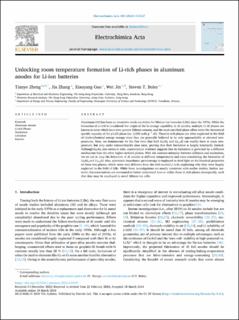| dc.contributor.author | Zheng, Tianye | |
| dc.contributor.author | Zhang, Jia | |
| dc.contributor.author | Guo, Xiaoyang | |
| dc.contributor.author | Jin, Wei | |
| dc.contributor.author | Boles, Steven Tyler | |
| dc.date.accessioned | 2024-03-25T09:48:22Z | |
| dc.date.available | 2024-03-25T09:48:22Z | |
| dc.date.created | 2024-03-21T10:56:16Z | |
| dc.date.issued | 2024 | |
| dc.identifier.issn | 0013-4686 | |
| dc.identifier.uri | https://hdl.handle.net/11250/3124023 | |
| dc.description.abstract | Aluminum (Al) has been an attractive anode candidate for lithium-ion batteries (LIBs) since the 1970s. While the formation of β-LiAl is considered the origin of the Li storage capability in Al anodes, multiple Li-Al phases are known to exist which have even greater lithium content, and the most enriched phase offers twice the theoretical specific capacity of the β-LiAl phase (ca. 2,000 mAh g−1-Al). These Li-rich phases are often neglected in the field of electrochemical energy storage since they are generally believed to be only approachable at elevated temperatures. Here, we demonstrate for the first time that both Li3Al2 and Li2-xAl can readily form at room temperature, but only under extraordinarily slow rates, proving that their formation is largely kinetically limited. Although Li9Al4 also seems to exist, experimental evidence suggests that its formation is governed by a different mechanism than the other higher-ordered phases. With the constant interplay between diffusion and nucleation, we set out to map the behaviors of Al anodes at different temperatures and rates considering the formation of Li3Al2 and Li2-xAl. Also, systematic impedance spectroscopy is employed to shed light on the kinetical properties of these two phases, which seem very different from the well-studied β-LiAl, explaining why they were largely neglected in the field of LIBs. While these investigations are mostly consistent with earlier studies, further material characterizations are warranted to better understand how to utilize these Li-rich phases strategically, such that they may be employed in novel lithium-ion cells. | en_US |
| dc.language.iso | eng | en_US |
| dc.publisher | Elsevier | en_US |
| dc.rights | Navngivelse 4.0 Internasjonal | * |
| dc.rights.uri | http://creativecommons.org/licenses/by/4.0/deed.no | * |
| dc.title | Unlocking Room Temperature Formation of Li-Rich Phases in Aluminum Anodes for Li-ion Batteries | en_US |
| dc.title.alternative | Unlocking Room Temperature Formation of Li-Rich Phases in Aluminum Anodes for Li-ion Batteries | en_US |
| dc.type | Journal article | en_US |
| dc.type | Peer reviewed | en_US |
| dc.description.version | publishedVersion | en_US |
| dc.source.pagenumber | 1-11 | en_US |
| dc.source.volume | 485 | en_US |
| dc.source.journal | Electrochimica Acta | en_US |
| dc.identifier.doi | 10.1016/j.electacta.2024.144127 | |
| dc.identifier.cristin | 2256327 | |
| dc.relation.project | Norges forskningsråd: 342109 | en_US |
| dc.relation.project | Norges forskningsråd: 332081 | en_US |
| cristin.ispublished | true | |
| cristin.fulltext | original | |
| cristin.qualitycode | 1 | |

